25 Feb 2019
Melanie Bruder describes possible indications for use of thermoplastics and approaches to applying it to the animal patient.
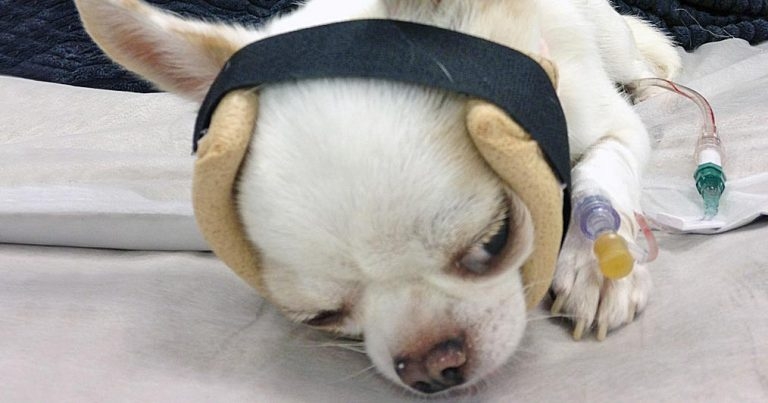
Figure 1a. A Chihuahua with an atlanto-axial subluxation in a thermoplastic immobilising splint.
Low temperature thermoplastics are widely used by therapists in human practice to manufacture splints. In this article, the author seeks to give readers an understanding of some of the possible indications for, and use of, these materials in the veterinary environment. She uses her experience as both a small animal physiotherapist and an occupational therapist to describe some of the practicalities of handling plastics and their application to veterinary patients.
This article gives a practical introduction to an emerging area within the veterinary field – particularly in the specialisms of rehabilitation, orthopaedics and neurology.
The term “orthotic” (from the Greek “to make straight”) applies to all forms of customised, external coaptation – widely referred to as braces, splints or appliances.
The use of low temperature thermoplastics to make complex orthoses in human medicine is largely a specialism in the field of occupational therapy. These orthoses, which are moulded directly on to the patient, are used for a variety of purposes, ranging from the immobilisation of fractures and serial stretching of soft tissue contractures, to protection of surgical repairs and functional positioning of a limb.
The author has more than 25 years’ experience in making these devices for children, and has more recently started to use them in her practice as a small animal physiotherapist. For the purposes of this article, they will be referred to as “splints”.
The skills required to make splints rest with the selection of the most appropriate plastic, designing and drawing out a pattern to fit and fulfil the function of the splint, moulding the splint, protecting against damage to the patient’s skin, securing the splint and educating the client. Thermoplastic splints are not suitable for every patient, or every case where external immobilisation is required; however, the author believes, used selectively by skilled staff, they have a useful role to play in some situations.
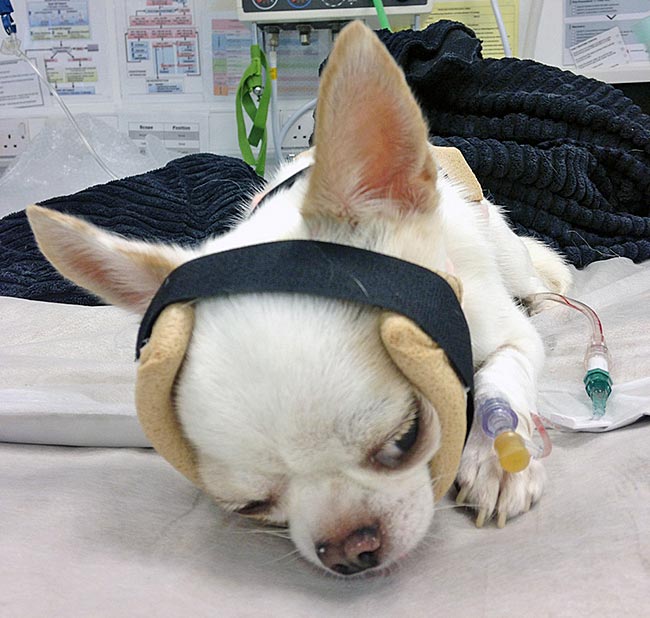
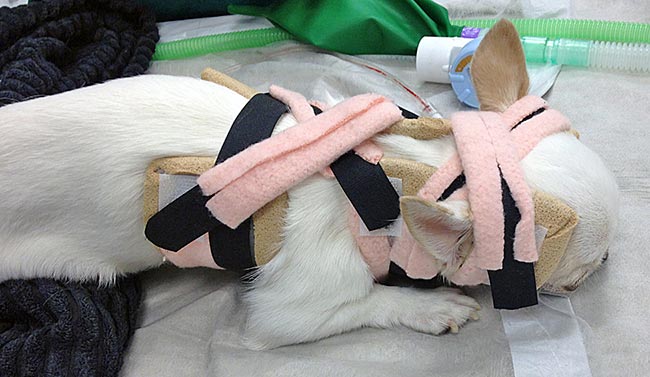
At this point it is helpful to look at the properties of thermoplastics, although these will vary with the particular make used.
Thermoplastics are sold as sheets, which soften when heated in hot water or in an oven. The splint is made by moulding the softened pattern to the individual patient and is available immediately. The plastics conform closely to achieve a good fit and can be remoulded to accommodate changing limb shape – for example, reduction in swelling or increased range of movement when splinting a contracture.
The plastics are very lightweight and can be fastened in a wide variety of ways – allowing for ease, or not, of removal. The beauty of custom-made orthoses lies in the flexibility of their application to individual need. Different thicknesses and rigidity of the material make them suitable for various uses – from a Chihuahua (Figures 1a and 1b) to a great Dane. The plastic can be flared out to remove pressure from chosen areas and have windows cut to allow inspection of small wounds without removing the whole device.
In selecting patients, the overriding principle of “do no harm” applies. Even in skilled hands, risks are associated with the use of splints. These relate mainly to the potential to cause pressure sores; however, careful manufacture and monitoring should minimise complications.
A wide variety of padding and lining materials exist, which can be chosen to protect the patient. Splints should, wherever possible, be moulded over the padding at the time of manufacture – as to pad after merely increases the pressure over a vulnerable area. It can be easy to make the mistake of putting padding into a finished splint either because a problem is anticipated, or because an area of skin has been damaged.
Splints have a role to play both in the management of acute and chronic conditions. The most common referral to the author’s service are dogs with carpal disorders, including congenital juvenile carpal flexion contractures, carpal hyperextension and carpal instability. The assessment of these relate to the function of the dog and the severity of the condition.
Options will include rigid plastic splints, neoprene splints with plastic reinforcement and neoprene-only splints. These are made directly on to the conscious animal and take about an hour to make. The wearing regime will be discussed with the owner and vet, but the splints are often used for periods of exercise. Ideally, they form part of an animal’s rehabilitation and are used to supplement a physiotherapy programme, so their use is under constant review. Clients will need to be committed, and require good education and follow-up. Poor owner compliance is generally a contraindication for the use of splints.
Thermoplastics have also been used for the management of acute or post-surgical cases. Immobilisation of the cervical spine – for example, in atlanto-axial subluxation, fractures and vertebral malformations – can be challenging.
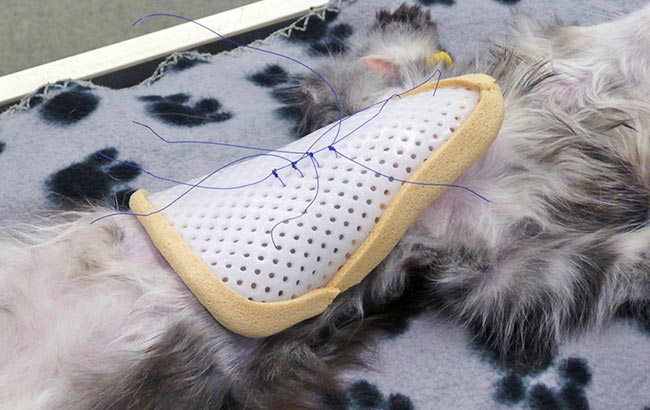
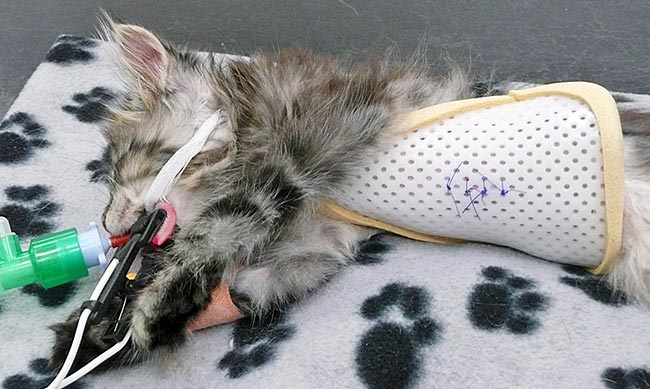
The use of thermoplastic splints offers a more flexible alternative to traditional casting materials. These splints may be made on an anaesthetised animal, but with good therapeutic handling, may, in some cases, also be made on a conscious patient. Additionally, wounds and pressure areas may be inspected and redressed without the need for further anaesthesia. These splints are more complex to make and require experience to attempt.
Careful consideration needs to be given to protect bony prominences, as the splint is likely to be worn for several weeks. The animal will probably require some degree of confinement, and attention to its sleeping and feeding positions will need to be given.
Ear infections are noted to be a complication of this treatment and these splints should not be used unless regular veterinary monitoring will be carried out. The splints can allow the vet easy access to inspect wounds and skin – often without anaesthesia – and the splint is simply replaced without having to make a new cast.
Plaster or casting materials can be heavy, clumsy and prone to producing sores; therefore, thermoplastics may be better tolerated. A good example of this is the use of a moulded device to splint the surgically elevated sternum in cases of pectus excavatum. The use of a thin, lightweight plastic with perforations allows for rigid splinting as the sternum remodels – also providing perforations through which sutures can be tied (Figures 2a and 2b).
The splint shown was very light, had padded edges and was secured with a thin layer of vet wrap. Three weeks later the splint was removed. The kitten had no skin marks and maintained correction of the deformity.
Thermoplastics are ideal for the serial splintage of contractures. Splints are made at sub-maximal stretch and remoulded at regular intervals as increased range is obtained. The Hungarian vizsla puppy pictured (Figures 3a to 3c) had three remoulds over 10 days to produce the correction.
Clinicians who wish to start using thermoplastics will need to learn very different skills than those associated with the application of casting materials. Splints usually involve either measuring the patient and drawing up a pattern or, occasionally, drawing a pattern around the animal directly on to the plastic. The pattern will use biomechanical principles of three-point control, and when splints are applied to limbs, should be approximately two-thirds of the length of the long bones involved.
Sharp scissors are essential and splints should have no ragged edges or pointed corners once cut out. A clear working area is generally preferable to a cluttered corner of the staff coffee lounge.
Other considerations include how the splint will be padded or if it will be made over synthetic padding. Moulding these plastics requires a flat hand approach where warm materials are smoothed or stroked to conform to the patient. Fingertip pressure will translate into indentations in the plastic once it has set and then become a pressure sore risk.
Splints are usually bandaged in place using an even pressure while they harden (usually about 5 to 10 minutes).
Different plastics will handle very differently in terms of drape, memory (the ability of the material to return to its original shape), perforation and resistance to stretch. It is important to thoroughly research these differences in the plastics before attempting to use them. The plastics suitable for making a carpal splint (Figure 4) are not necessarily fit for purpose for a neck collar.
Large splints will need several assistants to make as the plastics may self-adhere if they fold – an expensive mistake to make. Small splints can be heated using a kettle and washing up bowl, but, ideally, a water pan heater should be used. Most thermoplastics soften at temperatures between 60°C to 70°C.

The importance of appropriate strapping cannot be overemphasised. Straps may be made out of Velcro, adhesive sling material or bandages. The wider the strap, the better the distribution of pressure. Removable straps may be covered using sticking plaster or vet wrap for additional protection.
Clients will need to be shown how to apply and remove splints, and experience from working with human patients would indicate what may seem obvious when you make a splint is not necessarily obvious to the person who has to apply it at home with no one to refer to. Allowing clients to take photographs or video footage of the correct application can be helpful.
Important instructions include observing skin condition and warnings not to allow the splint to come into contact with direct heat. The consequences of Fido taking a kip in front of the fire in his splint could be catastrophic.
Splints that are worn intermittently should have regular review and an open appointment in case of problems. Splints that are left in place should be reviewed at least once a week.
As a small animal physiotherapist, the author receives all referrals for splints in writing from a vet. Vets or RVNs who wish to use thermoplastics in their practice can develop their skills in several ways. Most of the companies who make thermoplastics will have representatives that will demonstrate their range of plastics that staff are allowed to handle.
Additionally, some companies and hospitals will run courses on splint making. It may also be possible to observe an occupational therapist making splints. Hospitals with large orthopaedic or hand units often employ occupational therapists experienced in these skills. Pattern drawing can be practised on paper, but it is well worth investing in some plastics to try out, as no substitute exists for experimenting with handling the materials. A willing staff animal can be a great asset when learning to handle thermoplastics.
In conclusion, it is the opinion of the author that thermoplastics have a role to play in the treatment of the small animal patient and that their potential has not yet been fully realised. Successful use of splints depends on careful case and client selection, choosing the right materials, and prepared and skilled clinicians. Splintage is rarely a treatment on its own, but may play a part in the management of both acute and chronic orthopaedic or neurological cases.
The author would like to thank the following people for their help in the cases used to illustrate this article: Sarah Smith MA, VetMB, DVC, MRCVS (for reviewing this article, too); Lucy Travers BVSc, CertAVP, MRCVS; and Annette Wessmann DrMedVet, DipECVN, PGCertAcPrac, FHEA, MRCVS.